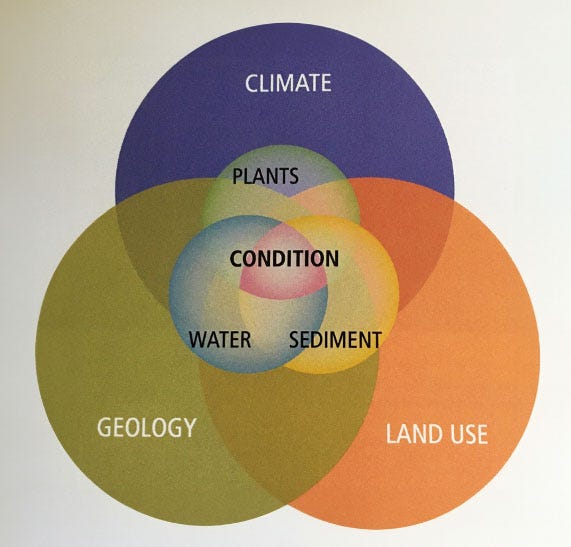NAPA VALLEY, Calif. — Even the occasional gardener is aware that plants require water to grow and reproduce. But many of us are clueless about the water cycle — the constant movement of water between the earth’s surface and the atmosphere via evaporation, condensation and precipitation. What happens to the rain that falls on our roofs, vineyards and driveways?
Several factors determine where all that rain goes and how moist or dry our landscapes will be at the end of the rainy season.
Geology plays a big role. What is your soil like, and are there rock formations? What is the region’s typical annual rain pattern — how much and how often? The regional vegetation —forest, grassland, wetlands — has an impact on rain retention. So does the way the land is used: Is it orchard, vineyard or impermeable parking lot? Sediment from soil erosion is another factor in rain’s fate after it falls.
The graphic below demonstrates the interlocking impact of these factors and how they determine the condition in your garden. The graphic is adapted from “Napa River Watershed Profile,” a report issued by the San Francisco Estuary Institute.
All of these factors determine how much rain our landscapes retain. They determine how deep tree roots must go to find groundwater. And they determine how much supplemental water beyond rainfall our plants will need to support their growth.
Our iconic coastal redwoods (Sequoia sempervirens) and other native plants that are adapted to our climate rely on fog in addition to rainfall. Plants that evolved in the eastern United States, where rain occurs year-round, often do not thrive in our Mediterranean climate. Southern magnolia, birch and many species of maple and ash tend to succumb to drought stress and associated diseases. If they can access groundwater, they might do well here. But if you want to plant shrubs or trees that are not adapted to a long dry season, you may want to determine whether your landscape has sufficient groundwater to support them.
If you have visited some of the Napa Valley gardens on the annual Climate-Friendly Garden Tours, you are probably familiar with the “slow it, spread it, sink it” mantra. These gardens are designed to maximize the amount of rain that remains on the property and to minimize runoff.
The larger the tree canopy in your yard, the cooler your microclimate. Tree roots also add organic matter to the soil, improving conditions for the soil microbiome. Roots enhance soil porosity and its water-holding capacity. Imagine a dry sponge soaking up water and releasing it slowly over time. That’s what healthy soil does.
In my own urban landscape, in years with late spring rains my Meyer lemon tree thrived into August without supplemental irrigation – most likely because it could access sufficient moisture stored underground.
Plants also release compounds through their leaves that can facilitate condensation of water vapor in the atmosphere and subsequent rain or snow. Researchers are coming up with remarkable findings about how rainfall is generated.
The main message for gardeners is that we need to consider our yards as part of a larger landscape. We can improve water retention on our properties in many ways, and adopting the “slow it, spread it, sink it” mantra is a good place to start. We all need to be more intentional in recognizing the interconnections between plants, soils and water.
Library Talk: Join UC Master Gardeners of Napa County and the Napa Library for “Discover the Las Flores Learning Garden” on Thursday, Jan. 4, from 7 to 8 p.m. via Zoom. Did you know that Napa has an amazing learning garden where you and your family can see examples of dry gardens, native plants and pollinator plants? Learn how Master Gardeners transformed part of Las Flores Community Center Park into an array of botanical teaching gardens. Register here to receive the Zoom link.
Workshop: Join UC Master Gardeners of Napa County for “Winter Rose Garden Care & Pruning” on Saturday, Jan. 6, from 10 a.m. to noon via Zoom. Prepare your roses for the upcoming growing season with this review of pruning techniques and best pruning tools. Learn how to help your roses cope with climate change and how to choose the right rose for the right place. Attendees will be invited to join a hands-on pruning workshop at Napa’s Fuller Park rose garden on Thursday, Jan. 11, from 10 a.m. to noon to practice what they learned. Register to receive the Zoom link.
Help Desk: The Master Gardener Help Desk is available to answer your garden questions on Mondays and Fridays from 10 a.m. until 1 p.m. at the University of California Cooperative Extension Office, 1710 Soscol Ave., Suite 4, Napa. Or send your questions to mastergardeners@countyofnapa.org. Include your name, address, phone number and a brief description. For best results, attach a photo.
Rainer Hoenicke is a UC Master Gardener of Napa County.





Perfect read for a rainy day in Napa...a lot of helpful information in a succinct article.
good article Rainer!!!!